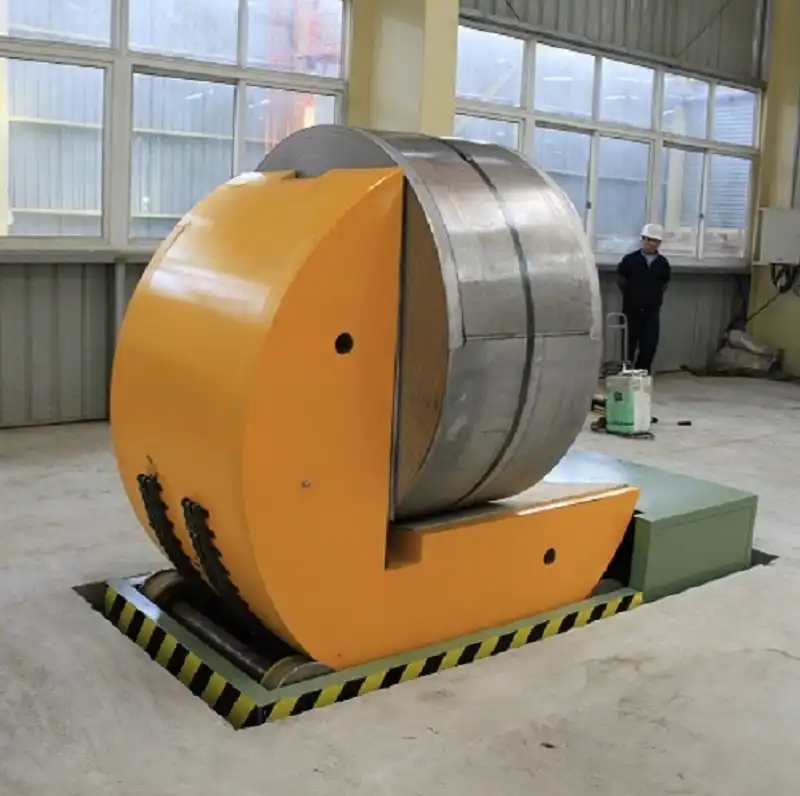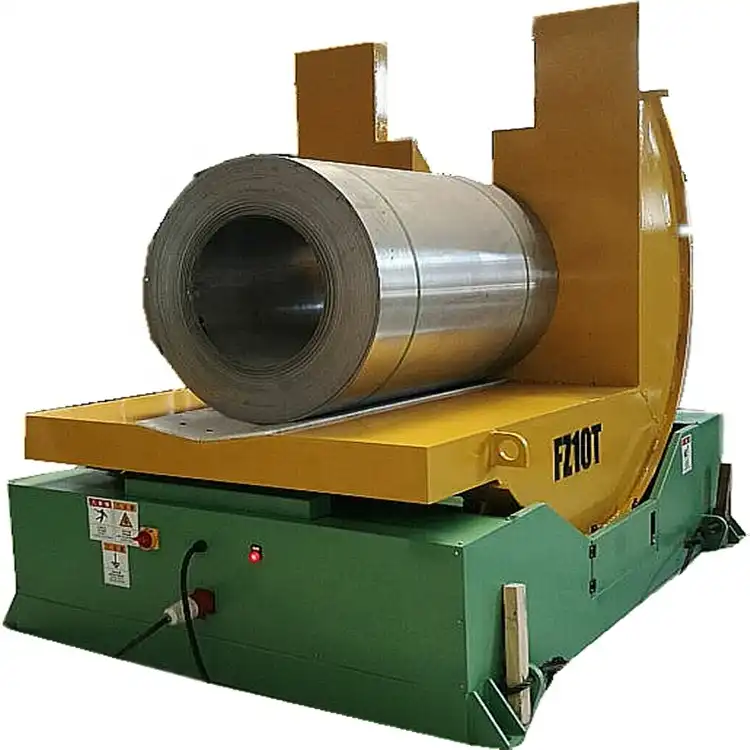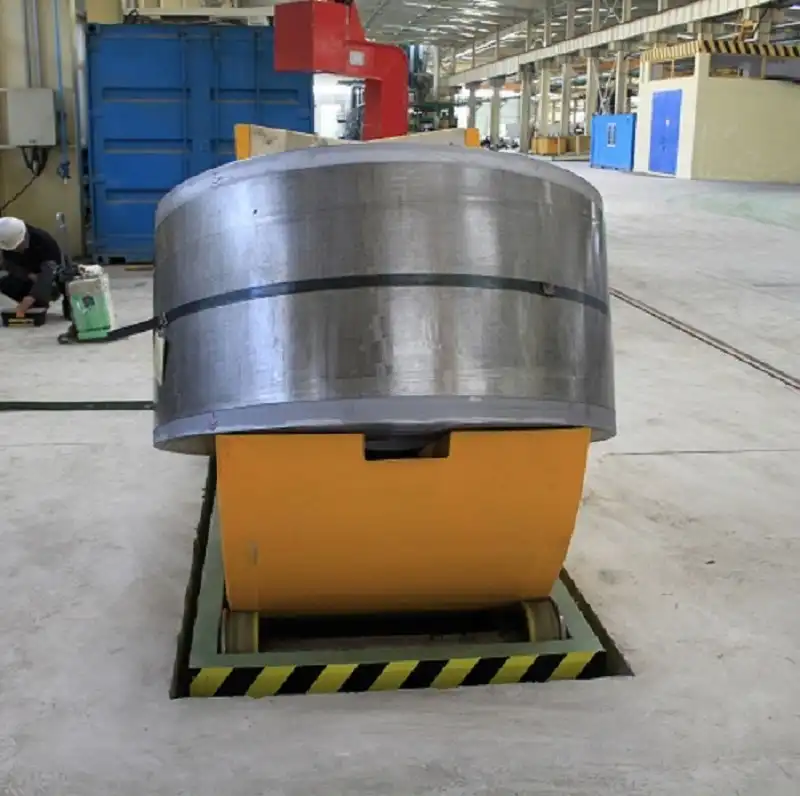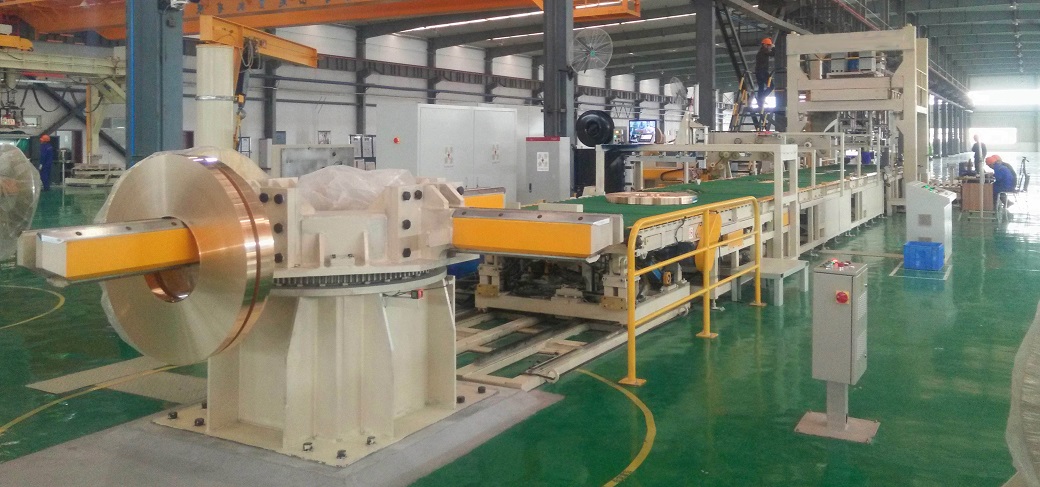Handling multi-ton molds and tools in a busy workshop is a serious challenge. I've seen it myself countless times. A team of workers struggles to manually flip a heavy die, using chains and an overhead crane. It's slow, inefficient, and incredibly dangerous. One slip can mean a catastrophic failure, damaging a tool that costs tens of thousands of dollars, or worse, causing a life-altering injury to a valued team member. This constant risk creates stress and slows down your entire production line, hitting your bottom line where it hurts. The pressure to improve safety and boost efficiency is immense, especially in a competitive market like Mexico's steel industry.
Choosing the right mold tilter for heavy tools in a Mexican workshop requires a careful, four-step evaluation. First, you must accurately assess the maximum weight and physical dimensions of your molds to determine the required load capacity and table size. Second, evaluate the necessary tilting angle, which is typically 90 degrees for most maintenance tasks, and select a robust mechanism like a hydraulic chain drive. Third, scrutinize the safety features and control system to ensure they protect your operators and integrate with your workflow. Finally, you should seek a strategic partner, not just a supplier, who understands the unique operational challenges in Mexico and provides long-term support.

I know that making a significant capital investment isn't as simple as following a basic checklist. When I was building my own factory, every equipment decision felt monumental. The details are what separate a successful investment from a costly mistake. You need to look beyond the spec sheet and consider how a machine will perform in your specific environment, day in and day out. Let's break down each of these critical points in detail. I want to walk you through the same thought process I use when evaluating equipment for my own operations, so you can make a choice with total confidence.
How Do You Determine the Right Load Capacity and Size for Your Mold Tilter?
Choosing a mold tilter with the wrong load capacity is one of the most common and dangerous mistakes a workshop manager can make. It’s a decision that can have severe consequences. If you select a machine that is undersized for your heaviest tools, you are creating a ticking time bomb. The risk of a catastrophic failure under load is real and terrifying. On the other hand, if you over-spec the machine and buy one that is far more powerful than you need, you are wasting precious capital that could be invested elsewhere to grow your business. This is a tough balancing act, especially when you are responsible for both the safety of your team and the financial health of the company.
To determine the right load capacity and size, you must start by creating a detailed inventory of the weight and dimensions of every mold and heavy tool you plan to handle. Once you have this data, always choose a tilter with a rated capacity that is at least 20-25% higher than your heaviest tool. This creates an essential safety buffer and prepares you for future needs. Also, you must carefully measure the length, width, and height of your largest mold to ensure the tilter's working table is big enough to support the entire base of the tool securely throughout the tilting process.

Creating a Precise Mold Inventory
This first step is non-negotiable. You cannot rely on old records or estimates. You or your chief engineer needs to physically go to the tool shop with a scale and a tape measure. Create a spreadsheet. List every single mold, die, and large fixture that will be handled by the tilter. Record its exact weight and its footprint (length and width). This data is the foundation of your entire decision. Without it, you are just guessing. In a steel mill environment, where tools are often modified or repaired, their final weight can differ from the original specifications. Accuracy here prevents costly errors later.
The Critical 25% Safety Margin
So why add 25% to your maximum load? It's about more than just a simple safety factor. This buffer accounts for several real-world variables. First is the dynamic load. When the tilter begins its motion, the forces exerted can momentarily exceed the static weight of the tool. Second, the weight distribution within a complex mold might not be perfectly even. The center of gravity can shift, placing unexpected stress on the equipment. Finally, this margin is about future-proofing your investment. A new project next year might require a slightly heavier mold. As a business owner like you, Javier, I know you’re always thinking five years ahead. Building in this capacity now prevents you from having to buy a second, larger machine later, saving you significant long-term cost.
Sizing the Working Table for Stability
The dimensions of the working table are just as important as the load capacity. The base of your mold must fit completely on the table surface, with no overhang. An overhanging tool is an unstable tool, and the risk of it slipping or tipping during the 90-degree tilt is unacceptably high. A good rule of thumb is to ensure the table dimensions are at least 15-20% larger than the mold's footprint. This provides a stable platform and gives your team room to place securing clamps or chains if needed.
| Mold Footprint (Length x Width) | Recommended Table Size (Length x Width) | Rationale |
|---|---|---|
| 1.5m x 1.0m | 1.8m x 1.3m | Provides a stable base, room for clamps. |
| 2.0m x 1.5m | 2.4m x 1.8m | Prevents dangerous overhang, ensures stability during tilt. |
| 2.5m x 2.0m | 3.0m x 2.4m | Accommodates very large tools securely. |
This methodical approach removes uncertainty. It transforms a potentially risky purchase into a calculated, safe, and forward-thinking investment that will serve your Mexican workshop reliably for years to come.
What Tilting Angle and Mechanism Best Suit Mexican Steel Mill Operations?
You've found a machine with the right capacity, but the job is only half done. Choosing a tilter with the wrong tilting angle or a weak mechanism can turn what should be a simple maintenance task into a major production bottleneck. Imagine this scenario: you invest in a new mold tilter, but it only tilts to 75 degrees. Your maintenance team now has to bring in an overhead crane and slings to finish the job, adding steps, wasting time, and reintroducing the very safety risks you were trying to eliminate. Or perhaps the tilting motion is jerky and slow, holding up a production line that costs your company thousands of dollars for every hour of downtime. The frustration is immense.
For the vast majority of mold maintenance, repair, and assembly tasks found in steel mills, a 90-degree tilting angle is the industry standard and the most versatile choice. The best mechanism for these heavy-duty applications is a powerful hydraulic system paired with a heavy-duty roller chain or a robust gear-motor drive. This combination delivers the smooth, controlled, and powerful movement that is essential for safely and reliably handling multi-ton tools in a demanding industrial environment like a Mexican steel plant.

Why 90 Degrees is the Magic Number
A 90-degree tilt is fundamental to workshop efficiency. It allows your team to take a mold half lying flat on its back (horizontal) and turn it completely onto its side (vertical). This simple action provides full, unobstructed access to the mold's cavity, cooling channels, ejector pins, and parting line surfaces. It makes cleaning, polishing, repairing, and component replacement drastically faster and safer. Trying to perform these tasks on a partially tilted mold is awkward and inefficient. Providing your team with a tool that achieves a full 90-degree tilt empowers them to do their job correctly and quickly, which directly contributes to reducing downtime and increasing your plant's overall productivity.
Comparing Drive Mechanisms for Heavy Loads
The mechanism that powers the tilt is the heart of the machine. For the heavy tools found in steel mills, you have a few options, but one stands out.
| System Type | Pros | Cons | Best For |
|---|---|---|---|
| Hydraulic with Chain | Enormous power, smooth motion, extremely reliable for heavy loads. | Requires a hydraulic power unit, potential for minor leaks over time. | Heavy-duty steel mill molds (>10 tons), harsh environments. |
| Mechanical (Screw Jack) | Simple design, very precise positioning. | Much slower, high wear on screw/nut with heavy loads. | Lighter loads, applications where speed is not critical. |
| Electro-Mechanical (Gear Motor) | Clean (no oil), excellent integration with PLC controls. | Higher initial cost, gearbox can be a complex failure point. | Automated lines, food/pharma grade environments. |
For a typical Mexican steel mill workshop, the hydraulic system is the clear winner. It offers the raw power needed to move 20, 30, or even 50-ton tools without strain. The smoothness of hydraulic power is also a key safety feature, preventing the kind of jerky movements that could shock-load and damage an expensive mold.
The Mexican Context: Built for a Tough Environment
Steel mills in Mexico are not clean rooms. They are hot, dusty, and operate around the clock. Your equipment must be built to withstand this. When evaluating a tilter, ask about its environmental protections. Are the hydraulic lines properly shielded? Is the gearbox sealed to prevent dust and grime from getting in? Are the electrical components rated for high ambient temperatures? A machine designed for a light-duty assembly shop will not survive long in your facility. You need a partner who understands this and builds their equipment accordingly, using heavy-gauge steel, robust components, and durable finishes. This focus on rugged construction is key to ensuring the long-term reliability you need.
How Do Safety Features and Control Systems Impact Your Workshop's Efficiency?
A powerful machine like a mold tilter without the right safety features is a massive liability. It's a disaster waiting to happen. And a machine with a control system so complex that your operators are afraid to use it is just an expensive piece of metal gathering dust in the corner of your workshop. An accident doesn't just harm your people; it can lead to investigations from the STPS (Secretaría del Trabajo y Previsión Social), costly fines, and a devastating blow to your team's morale. At the same time, an unusable machine represents a complete failure of investment, a monument to wasted capital that could have been used to achieve your production goals.
To avoid this, you must view safety features and control systems not as optional extras, but as core components that directly drive your workshop's efficiency and protect your most valuable asset: your people. Truly essential safety features like multiple emergency stop buttons, automatic limit switches, and physical safety barriers are non-negotiable. The ideal control system should be simple and intuitive, like a durable push-button pendant, or a more advanced PLC-based interface that is easy for operators to learn, allows for precise control, and can be integrated with your plant's central MES for better data and efficiency.

Your Non-Negotiable Safety Checklist
Safety is paramount. When I inspect a machine, these are the features I look for first. They are the difference between a safe workplace and a dangerous one.
- Emergency Stop Buttons: There must be multiple E-stop buttons, located on the main control panel and on the machine itself, within easy reach from any operating position.
- Limit Switches: These are critical. They automatically stop the tilting motion at the 0 and 90-degree positions, preventing the machine from over-tilting, which could cause the mold to fall.
- Overload Protection: The system should have both hydraulic and electrical overload protection. If the machine senses a load greater than its rated capacity, it should refuse to operate, preventing a catastrophic failure.
- Hose Burst Valves: This is a crucial hydraulic safety feature. If a hydraulic hose were to fail, these valves instantly lock the cylinder in place, preventing the heavy table from crashing down.
- Physical Guards and Fencing: A simple safety fence or light curtain barrier should create a designated safe zone around the tilter, preventing personnel from accidentally walking into the machine's path while it is in motion. Compliance with local Mexican safety norms (NOMs) is essential here.
Controls: Finding the Right Balance
The best control system is the one your team will actually use.
- Push-Button Pendant: This is the most common and often the best choice. It's a simple, handheld controller with buttons for "Tilt Forward," "Tilt Reverse," and "Stop." It is rugged, reliable, and requires minimal training. Your operators can learn to use it safely in minutes.
- PLC Control with HMI Screen: This is a more advanced option. A Programmable Logic Controller (PLC) with a Human-Machine Interface (HMI) screen offers more possibilities. You can program soft-start and soft-stop features for incredibly smooth motion, store pre-set parameters for different molds, and track usage data.
Connecting a Tilter to Your Digitalization Goals
Javier, I know that one of your key goals is to advance your plant's digital transformation by deploying an MES and using data analytics. This is where a PLC-controlled tilter becomes more than just a machine; it becomes a data source. It can communicate with your central system, reporting its operational status, cycle counts, and any fault codes. This data feeds directly into your goal of predictive maintenance and smart scheduling. Imagine getting an alert that a motor is drawing too much current before it fails. That is how you increase your equipment uptime to your target of 95% and reduce overall operating costs. It’s about making your equipment work smarter for you.
Why is a Strategic Partnership More Valuable Than Just a Low Price?
In any business, especially in capital-intensive industries like steel manufacturing, it is incredibly tempting to focus on the initial purchase price of a new piece of equipment. I've seen many companies make this their number one priority. And I have seen many of them pay a much, much higher price for that decision down the road. Imagine you save 15% on a mold tilter from a supplier you found online. The machine arrives and it works, for a while. Then, six months later, a critical hydraulic valve fails. You call the supplier. No answer. You email them. No response. You can't get the spare part you need. Now, your entire mold maintenance process is at a standstill, creating a bottleneck that halts a multi-million dollar production line for days, or even weeks. That initial 15% "saving" has just turned into an enormous financial loss.
This is why the smartest investment you can make is not just in a machine, but in a relationship with a true partner. A strategic partner does more than just sell you a piece of equipment. They take the time to understand your business, your challenges, and your goals. They support you for the entire lifecycle of the machine, ensuring you get the maximum return on your investment. For a steel mill owner in Mexico, this means having a reliable ally who is committed to your success and understands the unique demands of your operational environment.

My Personal Experience: The Cost of a Bad Decision
When I was first starting my own packing machine factory, I was working with a tight budget. I made the exact mistake I just described. I chose a critical electrical component for one of our machines based almost entirely on its low price. The supplier promised it met all the specifications. Three months after we shipped the machine to our client, that cheap component failed. The supplier was unresponsive. They were a thousand miles away and had no interest in helping. I had to fly my best engineer out to the client's site, source a new, high-quality component locally at a premium price, and spend days fixing the problem. The cost of the repair, the flight, and the damage to my new company's reputation was ten times what I had "saved" on that component. That experience was a painful but powerful lesson. It was then that I vowed that my company, SHJLPACK, would be the kind of partner I desperately wished I had back then. We don't just sell machines; we sell reliability, trust, and long-term peace of mind.
How to Identify a True Partner
A strategic partner acts differently than a simple vendor. Here is what you should look for, Javier:
- Deep Technical Expertise: Do they ask you intelligent questions about your process? Can they discuss the challenges of a hot, dusty steel mill environment? Or are they just reading from a brochure?
- Customization: Your workshop is unique. A true partner won't try to sell you a one-size-fits-all solution. They will offer to modify the table size, adjust the control system, or add specific safety features to perfectly match your needs.
- On-Site Support in Mexico: Will they commit to sending their own engineers to your plant to oversee installation and commissioning? Crucially, can they provide hands-on training for your operators and maintenance staff in Spanish?
- After-Sales Commitment: This is the most important part. Ask them for their plan for spare parts. What is their warranty policy? What is their guaranteed response time for a technical problem? A good partner has clear, confident answers.
- Forward-Thinking Advice: A partner is invested in your goals. They should be able to discuss how their equipment can help you reduce energy consumption or how it can be integrated into your digitalization strategy. They think beyond the sale.
The True Cost of Ownership (TCO)
An analytical mind like yours understands that the purchase price is just one part of the equation.
| Cost Factor | Low-Price Vendor | Strategic Partner (SHJLPACK) |
|---|---|---|
| Initial Price | $85,000 | $100,000 |
| Downtime Costs (5 Yrs) | $60,000 (breakdowns, waiting for parts) | $5,000 (predictive maintenance support) |
| Repair & Parts Costs | $25,000 | $7,000 (quality parts, support) |
| Operational Inefficiency | $15,000 (slow, awkward to use) | $0 (optimized for your workflow) |
| Total 5-Year TCO | $185,000 | $112,000 |
The numbers speak for themselves. The "cheaper" machine ends up costing over 65% more in the long run. Choosing the right partner is the most fiscally responsible decision you can make.
Conclusion
Choosing the right mold tilter is more than a hardware purchase. It is a strategic decision for your workshop's safety, efficiency, and future growth. Find a partner, not just a supplier.


